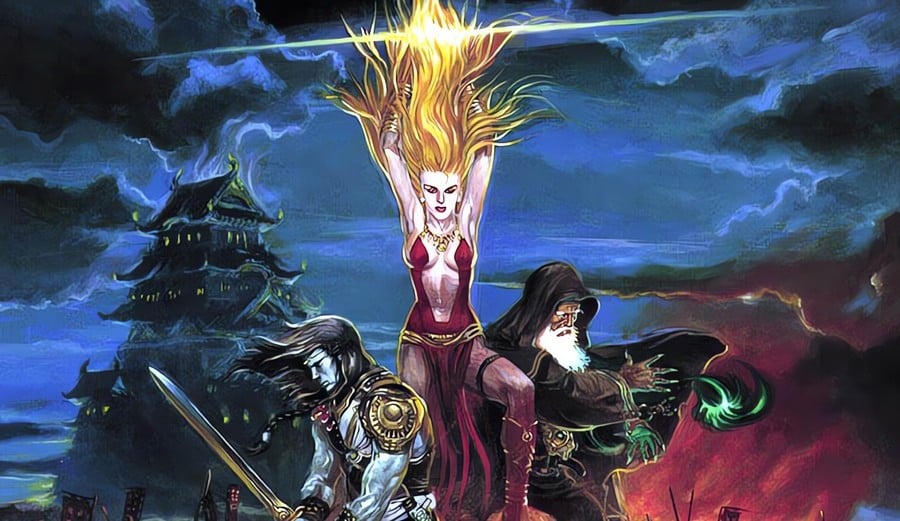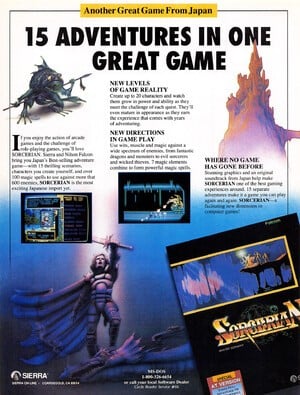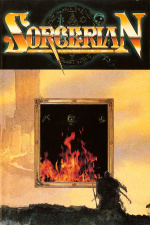
Do you remember 1997? The 64DD was announced and the hype / speculation train was in overdrive, on how its cheaper magnetic disks might integrate with compatible cartridges. Magazines of the period indulged in speculation on how it would provide additional quests, new items and equipment, characters, and so on, for any RPGs that came out. The as yet unreleased Zelda 64 was a central part of this fantasy. It was even joked about that annual 64DD add-on disks could exist for Link as he grows into adulthood.
The excitement around this new technology is unsurprising. This was an era where computer games were enjoying the benefits of expansion packs. You bought and played a game and then, should you want more, you would go out and physically buy an expansion pack, install it alongside the base game, thus receiving more content. They were cheaper than a full retail game, and weren't quite sequels, but they offered another slice of the cake if you owned the original. As digital distribution became the norm, these expansion packs evolved into DLC. Today the ability to buy extra story quests, characters, items, maps – you name it – is not just common place; it is expected.
But what if we told you that the dreams of N64 and PC gamers in 1997 had actually been achieved a decade earlier in 1987, and maybe even before that? Welcome to Sorcerian – one of the most remarkable JRPG series you've probably never played.

For setting a precedent, Sorcerian is phenomenally important. It was an early attempt at creating a re-usable game engine, by having a System Disk and then separate Scenario Disks which could be made by anyone – including other companies. The mechanics would be broadly the same, but thematically you could do whatever you wanted. Not quite Unreal Engine, but an early nod in that direction. Not only were there new quests, but also a Utility Disk for players to visit new merchants and purchase exclusive equipment not available In the main game. These Utility and Scenario disks are comparable to PC expansion packs or – more significantly – modern DLC in something like Mass Effect.
The series was also a lot of fun, offering an incredible level of freedom for the time. A player's name, age, race, class, and occupation could be selected and tweaked, and you would use these characters right up until they died of old age. Over long campaigns, you'd develop an affinity for them, slowly raising their stats and changing jobs as they moved across the various expansions, eventually passing away. Even Peter Molyneux's similarly envisioned Fable could not achieve the ambitions of Sorcerian! Then there's its magic system, which is so complicated we're reluctant to describe it for fear of putting you off.
Sorcerian was created by Yoshio Kiya, who is, alongside Tokihiro Naito and Yuji Horii, one of the forefathers of the Japanese RPG as a genre concept. He was a key pillar at early-era Falcom. We spoke with before, focusing on his Dragon Slayer series. We never actually covered Sorcerian, though, which is the fifth entry in the Dragon Slayer series.
"It wasn't Dragon Slayer V to start with," insists Kiya, when we interviewed him. "For other games up to that point Falcom would start making the game and it would get decided later on. But I didn't want anyone else to snatch up that title before we were able to use it, so I decided on it right from the beginning. I think it basically came from the word sorcerer; I decided that the name Sorcerian sounded like a good fit for this kind of game."
And from this single word, a 35-year series was born. Kiya went on to explain how the mechanics and ideas flowed from this starting point. "We decided on the name Sorcerian, and since it's called that we decided it's got to have magic, so it all pretty much branched out from there. With Xanadu there was a lot of variety with the number of characters, and stuff like that, and people were really surprised. So based on that we decided, OK, for this game we want numbers! From the start we decided to include a lot of spells."
Yeah, that magic system... Magic is ridiculous. Or rather, ridiculously awesome in its complexity. The manual has 35 pages dedicated to it, given there are over 150 types of magic. The system is split between herbal magic (based on five sacred herbs) and then magic governed by seven planetary gods and five elemental types. There are 31 types of herbal magic, 71 offensive magic, 37 Defensive magic, plus 12 other miscellaneous magic spells. Kiya wasn't kidding, because that's over 150 in total! (It's also possible we lost count – but trust us, there's a lot!)
Kiya focused on volume in other areas, too, with there being 60 occupations for your created characters to work at. You create any number of characters and then have four of them attempt to complete scenarios. The occupations affect a character's annual income and experience gain, and they can change jobs during their lifetime. For you see, your group of four friends aren't exclusively treasure-hunting monster-killing adventurers like in other games. They're normal people who meet up in their spare time to quest together. In a way it is a very literal mirroring of playing D&D with friends.
The main reason for discussing Sorcerian today, though, isn't so much its volume of content, but its modular style of design, which allowed for regular expansions. Now, in fairness, Sorcerian is not the first game to feature expansions. In America there are examples as early as 1981, such as when Temple of Apshai received an expansion.
For Japanese examples we spoke to Takayuki Komabayashi, games historian and member of Japan's Game Preservation Society. "Expansion packs for PC games, mainly scenarios... If we're talking only in Japan, I think it would be Kaleidoscope (1985, HOT-B)," Komabayashi tells us. "An additional scenario called 'Hakkan Wakusei' was released the next year. Also Daisenryaku Powerup Set (1986) and Xanadu: Scenario II (1986) were released."
"I did not really want to make Xanadu: Scenario II," laments Kiya. "Falcom president Kato-san basically wanted to make more money, so he told me to make it. So I felt, OK, I have no choice. He wanted to make more money; he wanted to get a bonus for everything, so ordered me to do it. And that really was not fun at all. So while I was making that, I also started secretly making Romancia on the side."
If you've read our previous article on Kiya, you'll get the impression he regards his earlier games as training – understanding the limits of floppy disks and the available hardware, and refining his programming. In many ways it was all a build up to Sorcerian and its unique structure.

"I wanted to make it like an Operating System," reveals Kiya. "At the time, using things like CPM or MS-DOS to make games, each time we had to create everything from the ground up. I got tired of doing that. So I figured, OK, I'd like to make a system where you've got the main game disk, and the data there, and then everything else can come separately as a module. That would make it easier to produce games from then on." Kiya basically created a re-usable game engine at a time when other developers were reinventing the wheel with each new title.
The underlying game logic could be re-used, with additional stories or content made as needed. Which is ironic, given that he had little interest in scenario stories – for Kiya, making games was more about the technical challenge of manipulating the hardware. Though in the end even he dabbled in scenario creation. "Originally all the other companies used stories in their games, for example Hydlide was based on a story, and I felt that the story was deciding things for the players and I did not like this. I thought the game's story is something the player should make themselves. But later on, looking at the reality, I understood that everyone liked 'running after' a story, so I also made scenarios. My picture was used for the Nageki no Shinden scenario in Sorcerian – they decided to sell it as 'the scenario that Kiya developed'. Personally I don't think you can really call it a scenario, because I decided there would be no story! <laughs>"
The base game, and first in the series, featured 15 distinct scenarios to embark on, mostly in any order (some required higher levels to succeed). They featured a variety of goals; retrieving stolen relics, solving murder mysteries, undoing curses, rescuing captives, and in one scenario even sabotaging a wedding! Each scenario featured unique monsters, collectibles, and environments. There was plenty to sink your teeth into; however, if you desired more, you'd simply acquire additional scenario disks to keep the adventures going.
"Sorcerian's expansion disks were released not only by Falcom, Takeru released some too," adds Komabayashi, describing the atmosphere in Japan at the time. "I think no one in doujin (hobbyist) circles made additional disks for Sorcerian, since reading Kiya's high level programming is not easy. But after the game's release, a monthly PC magazine gradually published information on how to solve the scenarios, and players rushed to buy the magazine, resulting in the game's long-lasting popularity. Many people drew illustrations of the characters and sent them to magazines. The music by Yuzo Koshiro was also especially popular."
Takeru was a software label by Brother Industries – it sold software through vending machines found in computer shops, rather than selling over the counter. Some scenario disks were sold through the Takeru vending machines; some scenarios were developed by a company called Amorphous; some scenarios were selected from the public. We asked Kiya if he worked with Takeru and how all this was arranged. It's unusual for 1987, since basically third-parties (and even players) were creating add-on content.
"I did not work with Takeru personally," explains Kiya. "I think Falcom was not involved either. However, Takeru did use the tools I created to work on the scenarios. After releasing Pyramid Sorcerian, Falcom decided to stop working on further extensions; it was the last scenario made within Falcom. There was a discussion about making more scenarios because it would be lucrative, but Falcom was reluctant to do the job. It was felt we wouldn't have time to spend on scenario creation, since we wanted to make other games. Then Amorphous, led by a former employee of Bullet-Proof Software named Conrad Kozawa, was introduced to Falcom to do the job. So Amorphous made Uchu-kara no Homonsha (Voyagers from Space) and Gilgamesh Sorcerian. Then there was a scenario contest by Comptiq magazine, which led to more scenario extensions."
Hopefully we've conveyed how exciting and revolutionary this must have felt in 1987. Sure, game expansions had existed before, but Sorcerian was taking it to new levels, involving other developers, vending machine distribution, science fiction and Egyptian themes, even player participation. For us, though, the most fascinating aspect of all this is the Utility Volume 1 disk.
Imagine playing the base game and completing many of the scenarios. Maybe getting an add-on disk for more scenarios. Then you come across Utility Volume 1. It's focus isn't more story quests, but rather it's a collection of bonus options, including allowing your characters to buy new equipment and learn new magic not available anywhere else. Basically, a "bonus shop" on a disk, where the things acquired could then be used in the preceding main game. The concept has a flavour almost like using Knuckles in Sonic 2, but much grander in ambition and several years earlier.
We asked Kiya if Falcom had wanted to make more Utility Disks. "There were not any concrete plans. I did feel it would be good to make another one, but as far as why we made it in the first place, it's kind of a dumb story. <laughs> we just wanted to show other programmers, hey, look what we can do! You guys said it was not possible to do this, but actually yes, we can do it - check this out! We really just wanted to show off our capabilities and be proud of it."
To get a better understanding of all this, we asked Joseph Redon, head of the aforementioned Game Preservation Society. "Yes, that was how the Utility Disk worked; it also had mini-games and extra contents, such as changing a character's name, fighting the last boss, a quiz game, music player, and so on. Too bad Falcom only released one… Note that PC-88 and later PC-98 versions of Sorcerian are different. They had the same scenarios, but different ways to complete them. You can even transfer your characters from PC-88 to PC-98."
Wait, what? The save data for versions of the game on different hardware was cross-compatible? It would seem, readers, that Sorcerian did more than we even realised. To fully appreciate this, know that the PC-88 and PC-98 are different hardware standards (8-bit and 16-bit). We debated other examples amongst Time Extension's contributors: Ashley Day cited transferring characters from Fire Emblem on GameCube to the sequel on Wii; this article's author thought of the Transfer Pak for N64, and uploading one's GB characters to Pokémon Stadium (rather apt, given our opening paragraph). Could Sorcerian be the earliest example of cross-compatible hardware transfers? If you know any others, post in the comments.
Redon was, however, quick to cushion the excitement of our discovery. "It only worked from PC-88 to PC-98, not the other way. The save transfer from PC-88 to PC-98 is a secret feature but easy to do: press shift while loading. The PC-98 version is said to be for 'busy' people, because, at that time, it was a business machine. So Kiya-san added a function to save anywhere, not just in town. And the idea to modify the scenarios between these two versions is genius – even if you completed the PC-88 version, even if you think you know how to solve a scenario, the solutions have been changed."
So the PC-98 version, which allowed the earlier PC-88 save data to be imported, was like a remix, we suggest? Redon agrees, elaborating on why he likes the scenarios. "The beauty of Sorcerian is variety," he says fondly. "Also the puzzle aspect of each, and the highly enjoyable dialogue. The cherry on the top being the music tracks, many of them from Yuzo Koshiro. Frankly the system is rather clunky, but the scenarios are still highly enjoyable even today, just like an old book of ancient tales."
Redon is a long-time enthusiast of the Sorcerian series and provided the cover scans you see on this page. He also linked us to two articles by the Game Preservation Society (first and second), the second of which gets very technical. He then informed us that one of the members of the GPS actually runs a Sorcerian fansite, cataloguing every related item. Take a look at how many are listed. We used Excel to count the list, and there are 300 entries over a 35-year period, right up to 2022. They're not all games, obviously, but that's still a lot of merchandise! You'd think with such a richly complex gameplay system, such ambitious design, and so much merchandise released, at least some of it would have left Japan. Right? Well, only one entry made it out. The original, localised and ported to DOS by Sierra in 1990.
None of the expansion disks made it over, so the game's most interesting quality went undiscovered. Sadly, it's not available to buy officially anymore, leaving only DOSBox and emulation. Also, the scrolling is jerky and the colour dithering an eyesore on modern LCD monitors. So what about fan-translations? The MSX2 version has a full patch, but it suffers from similar hardware limitations. The Sega-developed Mega Drive port and PC sequel Sorcerian Forever both have partial translations, though you'll lose a lot. The beautiful 2000 graphical remake of the original is still only in Japanese, as are all the other versions. There's a release on the Nintendo Switch, but again, it hasn't been localised.
We really want you to play Sorcerian. It is a rich, fascinating game with historical importance. Unfortunately, whatever option you choose, none are perfect. The DOS original will give you the best English language experience, but it's clunky and ugly. Later releases, remakes, and sequels look gorgeous, but you'll never leave the opening screen due to the language barrier, unless you understand Japanese. Even with the partial fan-translations, you're still missing out. Also, none of these choices replicate the feeling of getting extra disks, as with the PC-88 original.
There's something magical within Sorcerian. Given that the series still endures 35 years later, we can only hope someone, somewhere, either officially localises a newer release or the fans finish their translation work. It will have been worth the wait.

